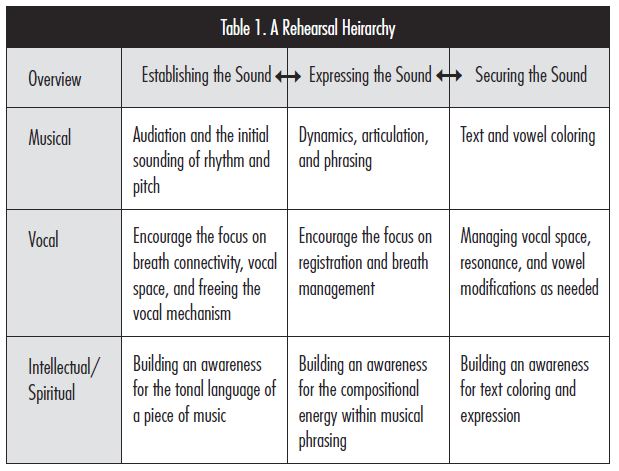The current issue of Choral Journal contains an article from Kyle Hanson titled “A Rehearsal Refresher.” I often hear from choral conductors and music educators that sometimes it feels as though they never have enough rehearsal time. In this article, the author provides “rehearsal refreshers” for reigniting our sense of purpose, joy, and beauty in our art form. An excerpt of the article follows. You can read the rest of this article from Kyle Hanson in the Rehearsal Break column of the May 2018 issue of Choral Journal here!
The anxiety of rehearsing is often marked by the question, “Where do I begin?” The frustration is primarily due to the interconnectivity between the musical, vocal, and intellectual/spiritual elements of a sound goal; each element intimately influences the other. For example, flat singing can be caused by poor pitch audiation, under-coordinated changes in registration, lack of or too much air support, an unfocused vowel, or dealing with the remaining frustration of heavy traffic on the way to work.
Like the finely tuned cogs within the gears of a clock, the final sound goal can remain unattainable if the smallest of gear is unconnected to the overall goal. In this way, the conductor must have a framework for analyzing sound and be able to strategically implement a rehearsal process that promotes musical, vocal, and intellectual/spiritual development throughout a piece of music.
Establishing a framework for deconstructing a sound goal into its key elements is paramount to providing effective rehearsal feedback while fostering an environment of awareness. To help support this rehearsal framework, one can fluidly move through stages of learning by first establishing the sound, then expressing the sound, and finally securing the sound. The rehearsal hierarchy chart in Table 1 (below), based upon the writings of James Jordan, establishes a paradigm for thinking about the order by which one can introduce these three concepts within the rehearsal process while still keeping the final sound goal at the forefront of inspiration.
For each rehearsal and within each moment of rehearsal, the conductor can fluidly move through these layers of learning in order to access the sonic potential of any group of singers. The key to any successful rehearsal, or rehearsal segment, hinges on the manner in which the conductor scaffolds learning and encourages awareness for the material being rehearsed.
*Table 1. James Jordan, The Choral Rehearsal: Technique and Procedures, vol. 1, Evoking Sound (Chicago, IL: GIA Publications, Inc, 2008).
Read the rest of this article in the May 2018 issue of Choral Journal here!
Note: you must be an ACDA member to read the Choral Journal. If you are not already a member of ACDA, join today! Associate members can join for only $45 a year and receive access to the Choral Journal online and other ACDA benefits.




Leave a Reply
You must be logged in to post a comment.